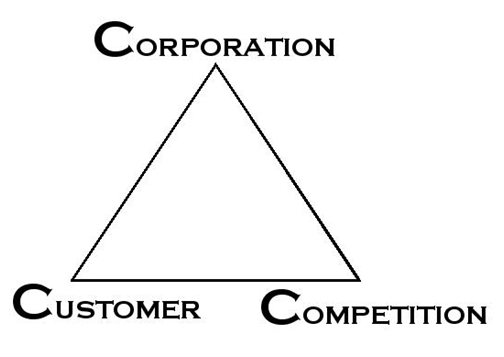Strategy

Strategy can be defined as “a method or plan chosen to bring about a desired future, such as achievement of a goal or solution to a problem” (Business Dictionary, 2013, online). Selection of an appropriate business strategy and its effective execution plays a critical role on long-term growth prospects of any business regardless of the industry and geographical location. This first part of the article represents an assessment of strategic options for Eurofreeze, a global manufacturer of frozen food. The article starts with specifying the current strategic position of Eurofreeze. This is followed by development and application of scoring criteria for Eurofreeze. The first part of the article is completed by formulation of strategic statement for specific strategic option that has been selected for Eurofreeze. The current strategic position of Eurofreeze involves market leadership in branded meat and fish dishes. This position has been achieved through effective utilisation of a range of company core competencies such as sophisticated freezer technology, regular development of new frozen dishes recipes, effective organisation of distribution channels and focus on own branded products. Moreover, compared to its main rival – Refrigor, Eurofreeze possesses additional competitive advantages such as leadership in European market and stronger brand name. Today massive changes are taking place in frozen food industry fuelled by further increasing bargaining power of large supermarkets, extension of supermarket own brand ranges of frozen food, and the desire of supermarkets to sell only one leading frozen food brand along with supermarket own brand products. In order to address these changes in an appropriate manner Eurofreeze has to select a strategy option from the following five broad options available: The first option for Eurofreeze involves stop selling branded frozen food, as well as, own label vegetables and fruit, but this is going to result in reduction in…

Critical success factors (CSF) can be explained as “an element of the organisational activity which is central to its future success” (Botten, 2009, p.20). The following table presents explanation of Starbucks Critical Success Factors in the UK market: CSF Explanation Quality of products Increasing level of competition in the market is fuelling the level of customer expectations regarding the quality in general, and freshness in particular Customer services Excellent customer services are being adopted as an important source of competitive edge by increasing numbers of coffee shops Shop design Coffee shops in the UK are being positioned as a ‘third place’, where people can spend most of their time apart from workplace and home (Dolan, 2012).Accordingly, relevant atmosphere needs to be developed with the interior, music and design. Social responsibility The impact of corporate social responsibility on profitability has increased significantly in the past several years. Accordingly, the level of engagement in fair trade, recycling policies, carbon emission policies, and employee treatment can be specified as important success factors for branded coffee shops like Starbucks Customer loyalty reward programs In catering industry consumer behaviour is greatly impacted by the level of attractiveness of loyalty programs that offer discounts and other advantages to loyal customers Starbucks Corporation Report uploaded on April 2017 contains the application of the major analytical strategic frameworks in business studies such as SWOT, PESTEL, Porter’s Five Forces, Value Chain analysis and McKinsey 7S Model on Starbucks. Moreover, the report contains analyses of Starbucks’s business strategy, leadership and organizational structure and its marketing strategy. The report also discusses the issues of corporate social responsibility. References Botten, N., 2009. Enterprise Strategy, Elsevier

Starbucks Coffee Company is a global coffee company and a coffeehouse chain headquartered in Washington, the US, and the company operates 18,000 retail stores in 60 countries (Starbucks Company Profile, 2012, online). Starting operations in Seattle in 1971, adherence to its mission statement of ‘to inspire and nurture the human spirit – one person, one cup and one neighbourhood at a time’ coupled with an aggressive utilisation of international market expansion strategy have contributed to net revenues of more than USD11.7 billion generated during the financial year of 2011 (Fiscal Annual Report, 2011). Since entering the UK market in 1998, Starbucks currently operates 607 stores in the UK, and there are 128 Starbucks licensed stores in the country (Fiscal Annual Report, 2011). However, the company is faced with significant challenges in the UK market that relate to tax issues, and these challenges are threatening with negative implications on Starbucks growth prospects in the UK. Starbucks operates in a highly competitive industry with the top competitors including Costa, McDonalds, Dunkin Brands Group and others. Moreover, the company faces stiff competition from local cafes as well. Starbucks has licensing agreements with a wide range of companies and “the company’s significant licensing agreements include the North American Coffee Partnership, a joint-venture with the Pepsi-Cola Company in which Starbucks is a 50% equity investor, manufactures and markets ready-to drink beverages, including bottles Frappuccino beverages and Starbucks DoubleShot espresso drinks in the US and Canada” (Company Description, online, 2011). Starbucks Corporation Financial Analysis A brief Starbucks Corporation financial analysis for the year of 2010 will ensure greater depth to the current report. Starbucks faced serious financial difficulties at the end of 2007 and beginning of 2008 partially associated with the global financial crisis. However, the company performance started to improve the following years once Howard…
By John Dudovskiy
Category: Finance

Strategic Human Resource Management (SHRM) can be explained as “a general approach to the strategic management of human resources in accordance with the intentions of the organisation on the future direction it wants to take” (Giri, 2008, p.21). In simple terms, SHRM attempts to achieve a high level of integration between corporate strategy and HRM. SHRM is perceived to be a much wider concept than traditional HRM in a way that SHRM addresses the impact of a range of factors on HR practices. Moreover, four major distinctive points of SHRM from traditional HRM can be specified in the following manner: a) SHRM concentrates on the level of efficiency of individual employee performances b) The importance of regularly introducing changes and organisational re-engineering is acknowledged within the framework of SHRM c) SHRM recognises the role of effective organisational leadership d) SHRM concentrates on team learning and sharing knowledge within organisations Evolution of HRM into SHRM, and its increasing role in organisational performance owes to intensifying level of competition in the marketplace. In other words, with the level of competition in the market becoming intense for almost all industries, businesses are actively striving to explore additional sources of competitive advantage. From this perspective, company human resources are proving to be an effective source of competitive edge through their creativity, and thus strategic approach to HRM is required in order to develop and sustain this important competitive edge. There are many examples in business world that illustrate positive implications of adopting strategic approach to HRM on organisational performance. For example, in UK based John Lewis plc 81,000 employees are called as Partners (Our Employees, 2012), and accordingly company human resources are treated as strategic partners in the achievement of long-term aims and objectives. Managers are recommended to approach HR aspect of the business…
By John Dudovskiy
Category: HRM

Stakeholders can be defined as “groups or individuals who can affect or be affected by the achievements of a business” (FT Lexicon, 2012). Key stakeholders in training transfer consist of organisations implementing training programs for their workforce, individuals undergoing the training course, and trainer conducting the training course. Each of these stakeholder categories has their roles and responsibilities that impact the outcome of the training in general, and the outcome of training transfer in particular in a direct manner. Organisations sponsoring training programs for their employees are directly interested in the high level of training transfer. Managers representing organisations have the responsibilities of “participating in the training needs investigation, supporting and briefing participants before, during and after the training, setting measurable objectives and rewarding the practice of learning” (Donovan and Townsend, 2004, p.42). Neglecting these responsibilities might be associated with the risks of wastage of financial resources invested in employee training and development initiatives. Audi UK, a car manufacturer originated in Germany serves as a good case study illustrating the immense role of organisation as a key stakeholder in the facilitation of training transfer. In Audi UK employees at all levels regularly participate in a wide range of training and development programs that are organised with the participation of highly competent professionals. Moreover, along a wide range of relevant initiatives Audi UK achieves a high level of training transfer for employees through follow-ups with employees to analyse the extent of application of knowledge and skills gained by employees during training courses. The roles of organisations as a key stakeholder in the provision of training and development programs and contribution to the level of training transfer also depend upon the sector organisations belong to. Specifically, private sector organisations enjoy greater level of freedom in terms of the selection of the training…

Regardless of its industry, size or other variables, firm’s marketing strategy needs to be aligned with the overall corporate strategy in order for the firm to be able to grow in long-term perspective. To put it simply, rather than being independent of corporate strategy, strategic marketing needs to be able to contribute to the achievement of strategic objective an en efficient manner. It has been stated that “because the link between marketing strategy and shareholder value has not been made, boards have tended to look at two other more transparent strategies. One has been cost reduction – sometimes disguised by more appealing names such as reengineering, downsizing or right sizing. …The other common remedy has been acquisition” (Doyle, 2008, p.19). References Doyle, P.(2008) “Value-Based Marketing” 2nd edition, John Wiley

Strategic marketing can be defined as “identification of one or more sustainable competitive advantages a firm has in the markets it serves (or intends to serve), and allocation of resources to exploit them” (Business Dictionary, 2012). As opposed to short-term view on marketing, strategic marketing calls for a structured and strategic approach in formation of marketing objectives, as well as, selection and implementation of marketing techniques and communication channels in order to achieve these objectives (Avasarikar and Chordiya, 2007). Practical benefits offered by strategic marketing include searching and identifying competitive edge for the business, easily clarifying long-term and short-term marketing objectives, obtaining guidance for operational decisions, and gainig a strong sense of the purpose for the company (Egan and Thomas, 2012). Strategic marketing process is divided by Cant et al. (2009) into three steps: planning, implementation, and evaluation. The planning step in strategic marketing process involve such activities as analysing current situation, setting specific goals, and formulating strategies that would assist in achieving these goals. Importantly, analysis of current situation in the marketplace should be undertaken with the primary aim of identifying gap in the market and sources of competitive edge for the firm. During the implementation step the chosen strategy is implemented on a practical level and all of the necessary financial and human resources are secured and attracted for this purpose. Unforeseen circumstances may occur during strategy implementation step that can create substantial challenges for management (Burrow, 2008). These difficulties may result due to the changes in the marketplace or inefficiencies associated with the formulating of the marketing strategy. The last step, evaluation deals with analysing the outcome of strategy implementation and comparing results against goals that have been set during the planning step. One of the main objectives at this stage can be specified as identifying…

Introduced by Kenichi Ohmae, 3 C’s Model deals with factors that can assist in achieving success for a marketing campaign (Lamb et al., 2011). Namely, 3 C’s stand for corporation, customer and competitors that are known as elements of strategic triangle. Corporation needs effective strategies so that current competitive edge can be further strengthened and additional sources of competitive advantages can be obtained. Specifically, corporate-based strategy involve selectivity and sequencing that involves formulation of competitive advantage, make or buy, that involves reviewing potential for outsourcing some operations, and improving cost effectiveness in relation to various business processes. Customer is seen as the base of any strategy. Accordingly, corporations need to identify their customers clearly by engaging market segmentation on the basis of objectives and customer coverage. Competition can be specified as another important factor. The negative impact of this factor can be minimised through building upon power of the image, capitalising on profit and cost structure differences, and using tangible and intangible resources in a rational way. The practical value of 3 C’s Model relates to identification of important factors effecting marketing strategy and dealing with these factors in an appropriate manner. References Lamb, C.W, Hair, J.F & McDaniel, C. (2011) “Essentials of Marketing” Cengage Learning

One of the popular definitions of policy reads as “a statement by government – at whatever level – of what it intends to do about a public problem” (Birkland, 2010, p.9). Accordingly, the issues of policy process are mainly discussed in the literature in relation to government policies. Tesco packaging policy is based on the following five key principles: being fit for purpose, using the lightest materials in terms of weight, using materials from the most sustainable sources, maximising the opportunities for recycling and recovery, and designed in a way that the lowest carbon impact can be achieved (Waste and packaging, 2012, online). According to Peters (2009) the Stages Model of Policy Process consists of the following stages: issue emergence, agenda setting, alternative selection, enactment, implementation and evaluation. All of these stages can be analysed in an individual manner in relation to the packaging policy of Tesco. Issue emergence of the policy process is an initial stage when specific problems are identified that need to be dealt with. Issues that require the introduction of relevant policies may arise fuelled by a wide range of reasons such as disasters, or any other dramatic changes. In terms of Tesco packaging policy this stage corresponds with increasing role of corporate social responsibility (CSR) aspect of the business in general, and the level of ‘greennes’ in particular. In other words, defined as responsibilities of business towards society apart from profit maximisation (Blowfield and Murray, 2008), CSR has emerged as a crucial aspect of the business to be dealt with by Tesco. The agenda setting stage of policy process corresponds with the issue growing to an extent that it requires immediate and due attention. It has been stated that “agenda setting occurs when the key players focus on an issue problem, which can be…
January 2, 2013
By John Dudovskiy
Category: Corporate Social Responsibility
Tags: Ethics, Retail, Sustainability

Note: the following post is from 2012. You can access the latest Hilton Worldwide Holdings Inc. Report published in August 2016 here. Hilton Hotels & Resorts is global hotels and resorts company with more than 540 locations in 78 countries (A Room for You, 2012, online). The parent company, Hilton International comprises a range of famous brands such as Waldorf Astoria Hotels & Resorts, Conrad Hotels & Resorts, Doubletree, Embassy Suites Hotels, Hilton Garden Inn, Hampton Inn, Homewood Suites by Hilton, Home2 Suites by Hilton, and Hilton Grand Vacations (Our Brands, 2012, online) Position of Hilton Hotels & Resorts within Travel and Tourism Industry in the UK Travel and tourism industry in the UK represents one of the key sectors in the national economy and according the research conducted by Oxford Economics “travel and tourism’s total contribution to GDP in the UK was GBP 101 billion in 2011 or 6.7% of total GDP” (The World Travel & Tourism Council, 2012, online) The following figure represents the structure of the UK tourism industry, and within this structure Hilton belongs to accommodation category. Moreover, the UK is the second biggest market for Hilton Hotels & Resorts after the US, and thus the UK market represents a point of focus for Hilton strategic level management. Hilton Hotels Main Stakeholders and Their Interests Stakeholders of company’s including Hilton Hotels & Resorts can be divided into two categories: internal and external. Internal stakeholders represent parties that belong to Hilton such as shareholders and employees. The primary interests of shareholders are profit maximisation, whereas employee interests include gaining a wide range of tangible and intangible compensation from their employment. External stakeholders, on the other hand, are parties that do not belong to Hilton; nevertheless they have interest in the business from various perspectives. The…
